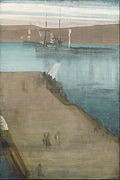
James McNeill Whistler
James Abbott McNeill Whistler RBA (/ˈwɪslər/; July 10, 1834 – July 17, 1903) was an American painter in oils and watercolor, and printmaker, active during the American Gilded Age and based primarily in the United Kingdom. He eschewed sentimentality and moral allusion in painting and was a leading proponent of the credo "art for art's sake".
James McNeill Whistler
July 10, 1834
July 17, 1903 (aged 69)
American
Painting
Founder of Tonalism
- 1884, elected honorary member, Royal Academy of Fine Arts, Munich, Bavaria, Germany
- 1892, made an officer of the Légion d'honneur, France
- 1898, charter member and first president of the International Society of Sculptors, Painters and Gravers
His signature for his paintings took the shape of a stylized butterfly with an added long stinger for a tail.[1] The symbol combined both aspects of his personality: his art is marked by a subtle delicacy, while his public persona was combative. He found a parallel between painting and music, and entitled many of his paintings "arrangements", "harmonies", and "nocturnes", emphasizing the primacy of tonal harmony.[2] His most famous painting, Arrangement in Grey and Black No. 1 (1871), commonly known as Whistler's Mother, is a revered and often parodied portrait of motherhood. Whistler influenced the art world and the broader culture of his time with his aesthetic theories and his friendships with other leading artists and writers.[3]
Early life[edit]
Heritage[edit]
James Abbott Whistler was born in Lowell, Massachusetts on July 10, 1834,[4][5][6] the first child of Anna McNeill Whistler and George Washington Whistler, and the elder brother of Confederate surgeon William McNeill Whistler.
In later years, Whistler played up his mother's connection to the American South and its roots, and he presented himself as an impoverished Southern aristocrat, although it remains unclear to what extent he truly sympathized with the Southern cause during the American Civil War. He adopted his mother's maiden name after she died, using it as an additional middle name.[7]
New England[edit]
His father was a railroad engineer, and Anna was his second wife. James lived the first three years of his life in a modest house at 243 Worthen Street in Lowell, Massachusetts.[8] The house is now the Whistler House Museum of Art, a museum dedicated to him.[9] He claimed St. Petersburg, Russia as his birthplace during the Ruskin trial: "I shall be born when and where I want, and I do not choose to be born in Lowell."[10]
Whistler was a moody child, prone to fits of temper and insolence, and he often drifted into periods of laziness after bouts of illness. His parents discovered that drawing often settled him down and helped focus his attention.[11]
The family moved from Lowell to Stonington, Connecticut in 1837, where his father worked for the Stonington Railroad. Three of the couple's children died in infancy during this period.[8] Their fortunes improved considerably in 1839 when his father became chief engineer for the Boston & Albany Railroad,[12] and the family built a mansion in Springfield, Massachusetts, where the Wood Museum of History now stands. They lived in Springfield until they left the United States for Russia in late 1842.[13]
Whistler achieved worldwide recognition during his lifetime:
A statue of James McNeill Whistler by Nicholas Dimbleby was erected in 2005 at the north end of Battersea Bridge on the River Thames in the United Kingdom.[152]
Auction records[edit]
On October 27, 2010, Swann Galleries set a record price for a Whistler print at auction, when Nocturne, an etching and drypoint printed in black on warm, cream Japan paper, 1879–80 sold for $282,000.[153]

















